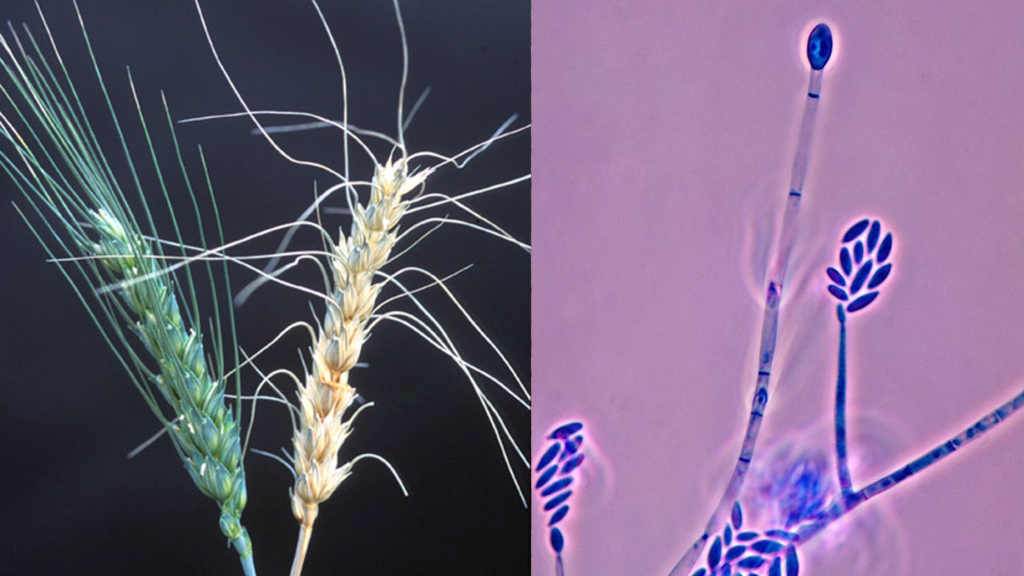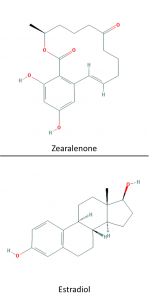#205: Zearalenone

Fusarium graminearum (left) and F. verticillioides (right), along with other Fusarium species, produce the toxin zearalenone. Zearalenone is the only mycotoxin that activates estrogen receptors. Left photo by the USDA’s Agricultural Research Service. Right photo by the CDC.
Zearalenone is a fascinating mycotoxin produced by Fusarium species. It is the only mycotoxin that mimics the effects of the hormone estrogen. In high doses, it causes sexual organs to develop incorrectly. Pigs are the most susceptible animals and suffer estrogenism and vulvovaginitis when exposed to high levels of zearalenone. The toxin is present in many grain-based foods intended for human consumption, but usually at very low levels. As a result, zearalenone is generally harmless to humans.1,2
Sources
Zearalenone is produced by a few different species of Fusarium, primarily F. graminearum (F. roseum), F. culmorum, F. verticillioides (F. moniliforme), and F. equiseti.2,3 These fungi also produce other mycotoxins; most notably, F. graminearum also forms deoxynivalenol (see FFF#203). Due to differences in growth conditions and strains, the other mycotoxins may dominate at certain times and zearalenone may dominate at others.1 Fusarium spp. infect grains and other seed crops, but are most significant in corn (maize) and hay. Cool, wet weather promotes the growth of Fusarium fungi, which usually infect crops during flowering.2,4 Under ideal conditions, the fungi continue producing zearalenone after being harvested, but most production occurs before the harvest.2

Although zearalenone does not look much like estrogens such as estradiol, zearalenone can fold in such a way that it binds to estrogen receptors. Photos by PubChem.
Structure and Mechanism
Zearalenone causes symptoms by activating estrogen receptors, despite the fact that it does not look like estrogen.5 The toxin has an unusual structure; there is a benzene ring attached to a 12-atom ring.6 Inside cells, this shape folds itself such that hydroxyl (-OH) groups are positioned in the same way that estrogen’s hydroxyl groups are.5 This allows zearalenone to bind the estrogen receptors ER-α and ER-β, although it binds ER-α more easily.2 Once bound, these receptors activate genes involved with the formation and maintenance of female characteristics and female sexual organs.1,2
Inside the body, various enzymes modify zearalenone, creating α-zearalenol and β-zearalenol. α-zearalenol binds estrogen receptors more strongly than zearalenone, while β-zearalenol forms weaker bonds. How different species modify zearalenone factors into how susceptible they are to the toxin. Most of these modifications occur in the small intestine and liver. Animals whose bodies convert most of the zearalenone to α-zearalenol will therefore be more susceptible to the toxin’s effects. Pigs are the most susceptible organisms, largely because their bodies convert zearalenone to α-zearalenol more than β-zearalenol.2
Symptoms
Pigs exhibit the most severe symptoms. When exposed to high levels of zearalenone, they can develop the conditions estrogenism and vulvovaginitis.1 Estrogenism refers to the complex of symptoms caused by ingestion of too much estrogen or estrogen agonists.7 In pigs, zearalenone-induced estrogenism involves enlargement of female sexual organs, irregular hormone cycles, and sterility in males.
Zearalenone causes the most severe symptoms in young female pigs, who can be exposed through contaminated feed or through their mother’s milk (if the mother is fed contaminated feed). Noticeable symptoms appear when the concentration of zearalenone is as low as 1 part per million (ppm). Young female pigs may develop enlarged mammary glands, an enlarged uterus, and vulvovaginitis. In vulvovaginitis, the vulva enlarges and excess blood vessels grow into the organ. In the most extreme cases, the vulva may get so big that it expands externally. Mature female pigs fed 3-10ppm of zearalenone exhibit aberrations in their hormone cycle. This causes decreased breeding efficiency and – if the concentration exceeds 30ppm – may kill early embryos. In young male pigs, the testes may decrease in size, potentially rendering them sterile. Adult male pigs are much less susceptible to the toxin, tolerating concentrations of up to 200ppm without any observable effects.1
Cows and sheep exhibit similar but less severe symptoms. Both animals can experience aberrant reproductive cycles and enlargement of female organs, depending on the age of the animal and concentration of zearalenone. Young male cattle can also become infertile. Depending on the type of cow, hormone cycles may be affected at concentrations of 10-20ppm. For cows and sheep, the primary impact of these symptoms is a reduction in reproductive efficiency.1,3
There is very little data about how zearalenone affects humans. A few researchers have suggested a link between the toxin and conditions such as precocious puberty (where children enter puberty too early) and breast cancer. However, there is not enough evidence to support that link. Presumably, both of those conditions occur because zearalenone overstimulates estrogen receptors.2
Impacts
The impacts on animals are fairly mild because most symptoms go away when the animals are no longer fed zearalenone. Most animals will return to normal in about a week. The major exception to this is young males that have become infertile as a result of zearalenone exposure. For farmers, the primary concern is that their animals will not breed as effectively while exposed to the toxin.1
Humans are rarely impacted by zearalenone. Even though the toxin is not destroyed by cooking – except in cooking methods involving alkaline solutions or extrusion cooking – humans are exposed to very little zearalenone. The Scientific Committee on Food recommends that humans ingest less than 0.2µg per kg of body weight. This limit is rarely exceeded in food products. If someone does ingest over that limit, she/he is most likely to do so for only one day in a row, which shouldn’t cause symptoms. The most common sources of exposure are grain-based products, such as cereals. Fortunately, normal processing of grains for human consumption reduces the amount of zearalenone. Even though zearalenone can become concentrated in animal tissues, humans cannot eat enough meat to approach the recommended limits of zearalenone exposure.2
Do not use information in this post to self-diagnose or self-treat a medical complaint. Always consult a licensed medical doctor for proper diagnosis and treatment of a health issue.
See Further:
http://onlinelibrary.wiley.com/doi/10.2903/j.efsa.2011.2197/epdf
http://www.merckvetmanual.com/toxicology/mycotoxicoses/estrogenism-and-vulvovaginitis
https://www.apsnet.org/edcenter/intropp/topics/Mycotoxins/Pages/Zearalenone.aspx
http://poisonousplants.ansci.cornell.edu/toxicagents/zearalenone.html
https://www.addl.purdue.edu/newsletters/2003/winter/zearalonenone.shtml
Citations
- Osweiler, G. D. Estrogenism and Vulvovaginitis. Merck Veterinary Manual Available at: http://www.merckvetmanual.com/toxicology/mycotoxicoses/estrogenism-and-vulvovaginitis. (Accessed: 8th December 2017)
- EFSA Panel on Contaminants in the Food Chain. Scientific Opinion on the risks for public health related to the presence of zearalenone in food. EFSA Journal 9, n/a-n/a (2011).
- Witte, C. The Presence, Effect, and Diagnosis of Zearalenone in Dairy Cattle. Indiana Animal Disease Diagnostic Laboratory (2003). Available at: https://www.addl.purdue.edu/newsletters/2003/winter/zearalonenone.shtml. (Accessed: 8th December 2017)
- Schmale III, D. G. & Munkvold, G. P. Mycotoxins in Crops: A Threat to Human and Domestic Animal Health: Zearalenone. American Phytopathological Society Available at: https://www.apsnet.org/edcenter/intropp/topics/Mycotoxins/Pages/Zearalenone.aspx. (Accessed: 8th December 2017)
- Zearalenone. Cornell University Department of Animal Science – Plants Poisonous to Livestock (2015). Available at: http://poisonousplants.ansci.cornell.edu/toxicagents/zearalenone.html. (Accessed: 8th December 2017)
- ZEARALENONE. PubChem Available at: https://pubchem.ncbi.nlm.nih.gov/compound/5281576. (Accessed: 8th December 2017)
- estrogenism. The Free Dictionary








![#011: Characteristics of Kingdom Fungi [Archived]](https://www.fungusfactfriday.com/wp-content/themes/hueman/assets/front/img/thumb-small-empty.png)

